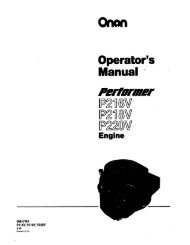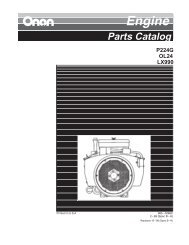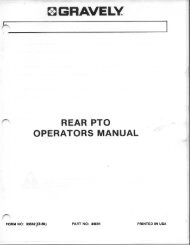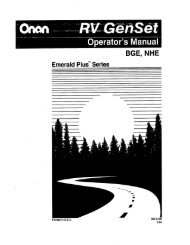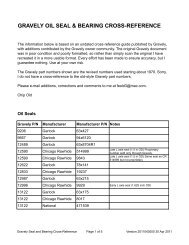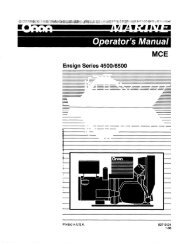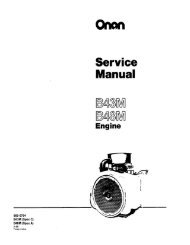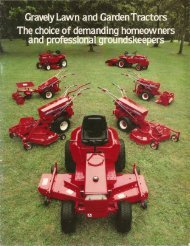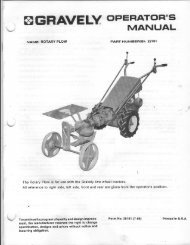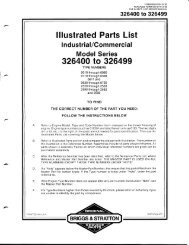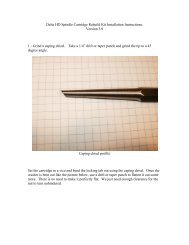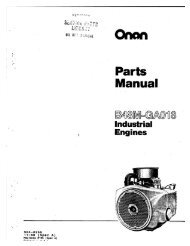272144 Vanguard Twin Cylinder OHV BRIGGS & STRATTON.pdf
272144 Vanguard Twin Cylinder OHV BRIGGS & STRATTON.pdf
272144 Vanguard Twin Cylinder OHV BRIGGS & STRATTON.pdf
Create successful ePaper yourself
Turn your PDF publications into a flip-book with our unique Google optimized e-Paper software.
NOTE: Recondition the cylinder bores to restore the<br />
crosshatch finish whenever new piston<br />
rings are installed to a cylinder that is within<br />
specification. Be careful not to hone the<br />
cylinder oversize or it will be necessary to<br />
resize the cylinder.<br />
Lubricate hone as recommended by hone<br />
manufacturer. The recommended drill speed is 300<br />
– 700 RPM and 40 - 60 strokes per minute.<br />
Because cylinder bores normally wear only in the<br />
area of ring travel (3), the cylinder bore will be round<br />
above and below ring travel area, Fig. 3 (B). Start<br />
drill and, as hone spins, move it up and down (7) at<br />
the bottom of the cylinder bore (4). Gradually<br />
increase the length of the strokes until hone travels<br />
full length of cylinder bore (8), but no more than 3/4<br />
– 1” (19 – 25 mm) above or below (6) cylinder bore,<br />
Fig. 3 (C). Lubricate hone frequently to prevent build<br />
up on stones.<br />
As cutting tension decreases, stop hone and tighten<br />
adjusting knob following hone manufacturer’s<br />
recommendations. Check cylinder bore frequently.<br />
Finishing<br />
Finishing stones are used after the cylinder bore has<br />
been resized to within 0.0015” (0.04 mm) of the<br />
desired size or when reconditioning a cylinder bore.<br />
The finishing stones will produce the correct<br />
crosshatch finish necessary for proper lubrication.<br />
The correct crosshatch angle is approximately 45º<br />
(1), Fig. 4.<br />
Recondition the cylinder bores to restore the finish<br />
when new piston rings are to be installed in a cylinder<br />
that is within specification. Do not to hone oversize<br />
or it will be necessary to resize the cylinder.<br />
NOTE: To produce the proper crosshatch finish use<br />
a drill speed of approximately 200 RPM and<br />
40 - 60 strokes per minute. Lubricate hone<br />
liberally to prevent build up on finishing<br />
stones.<br />
<br />
A<br />
B<br />
C<br />
<br />
<br />
ÓÓÓ<br />
ÓÓÓ<br />
ÓÓÓ<br />
ÓÓÓ<br />
<br />
ÓÓÓ<br />
ÔÔ<br />
<br />
ÓÓÓÓ<br />
ÓÓÓ ÓÓ<br />
ÓÓÓÓ<br />
ÓÓÓ ÓÓ<br />
ÓÓÓÓ<br />
ÓÓ<br />
ÓÓÓÓ<br />
ÔÔ ÓÓÓ<br />
ÔÔÓÓÓ<br />
ÔÔ ÓÓÓ<br />
<br />
ÔÔ<br />
ÓÓÓ<br />
<br />
ÔÔ ÓÓÓ ÔÔ<br />
ÔÔ ÔÔ ÓÓÓ<br />
ÔÔ ÔÔ<br />
Fig. 3<br />
<br />
Cleaning<br />
Fig. 4<br />
CAUTION: Honing grit is highly abrasive and<br />
will cause rapid wear to all the internal components<br />
of the engine unless it is completely removed.<br />
The entire cylinder and crankcase<br />
MUST be THOROUGHLY cleaned after honing.<br />
First wash the cylinder and crankcase carefully in a<br />
solvent such as kerosene or commercial solvent.<br />
Then thoroughly wash cylinder and crankcase using<br />
a stiff brush with soap and hot water. Rinse<br />
thoroughly with hot running water. Repeat washing<br />
and rinsing until all traces of honing grit are gone.<br />
NOTE: When cylinder and crankcase have been<br />
thoroughly cleaned, use a clean white rag or<br />
napkin to wipe the cylinder bore. If honing<br />
grit is present it will appear as a gray residue<br />
on rag. If any honing grit is evident, re-wash<br />
and rinse entire cylinder and crankcase and<br />
check again. When there is no trace of<br />
honing grit on rag, the cylinder has been<br />
properly cleaned. Oil the cylinder bore to<br />
prevent rusting.<br />
151




